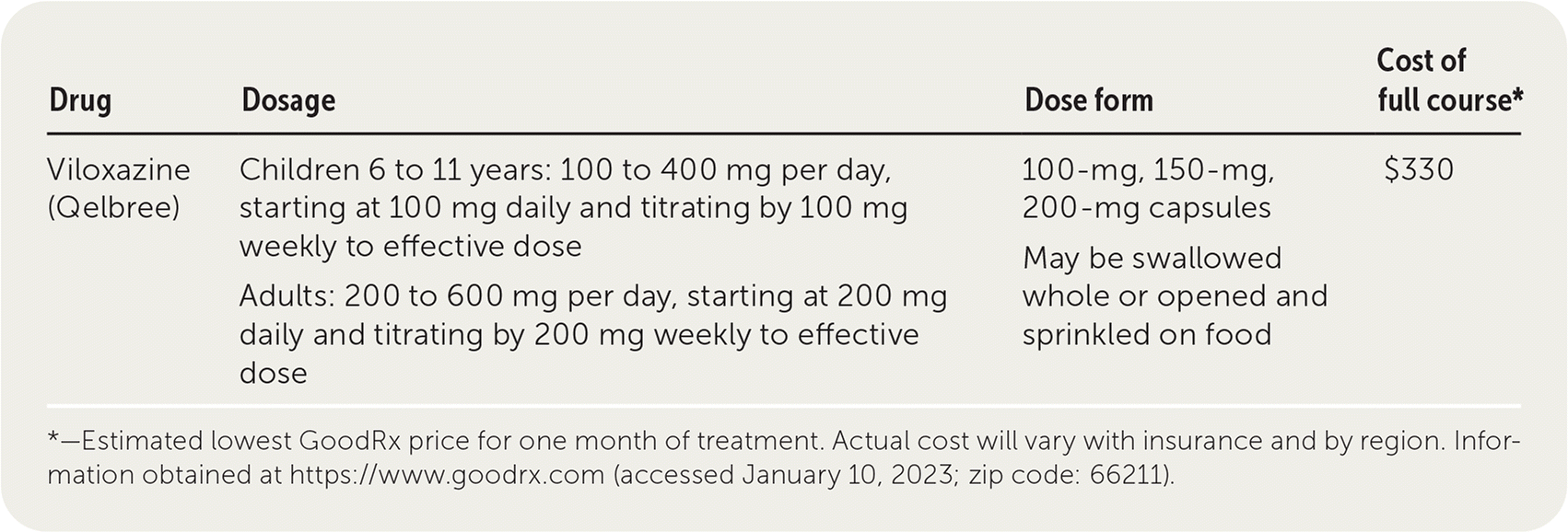
Am Fam Physician. 2023;107(3):309-310
Author disclosure: No relevant financial relationships.
Viloxazine (Qelbree) is a selective norepinephrine reuptake inhibitor labeled for the treatment of attention-deficit/hyperactivity disorder (ADHD) in adults and children older than six years.1

| Drug | Dosage | Dose form | Cost of full course* |
|---|---|---|---|
| Viloxazine (Qelbree) | Children 6 to 11 years: 100 to 400 mg per day, starting at 100 mg daily and titrating by 100 mg weekly to effective dose | 100-mg, 150-mg, 200-mg capsules | $330 |
| Adults: 200 to 600 mg per day, starting at 200 mg daily and titrating by 200 mg weekly to effective dose | May be swallowed whole or opened and sprinkled on food |
Safety
Viloxazine may cause suicidal thoughts and behaviors in children and adults. In 1,019 children and adolescents using viloxazine, nine (0.9%) reported suicidal thoughts or behaviors compared with two (0.4%) of those taking a placebo (number needed to harm [NNH] = 200).1 In pre-marketing studies of 189 adults taking viloxazine, three (1.6%) reported suicidal thoughts compared with no patients taking a placebo (NNH = 63); no suicidal behaviors occurred in clinical trials.1 Because similar noradrenergic medications may induce a manic or mixed episode in patients with bipolar disorder, the manufacturer recommends that patients be screened for bipolar risk factors, including a personal or family history of suicide or bipolar disorder.1
In small studies, viloxazine increased heart rates (greater than 20 beats per minute) in 20% to 30% of adults and children; incidence increased with higher doses.1
Viloxazine is contraindicated in patients who are currently taking or have recently taken monoamine oxidase inhibitors because the combination could induce a life-threatening hypertensive crisis. There are no data on the effects of viloxazine on pregnant patients or developing fetuses, or on its presence in breast milk. In animals, viloxazine has been shown to cause maternal and fetal toxicity. Viloxazine should be discontinued if pregnancy occurs.
Tolerability
Adverse effects with viloxazine are common and will cause 3% of children and adolescents and 9% of adults to discontinue the medication.1 The most common adverse reactions in children were somnolence (16% vs. 4% with placebo), decreased appetite (7% vs. 0.4%), fatigue (6% vs. 2%), nausea (5% vs. 3%), vomiting (4% vs. 2%), and irritability (3% vs. 1%). In adults, the most common adverse effects were insomnia (23% vs. 7% for placebo), headache (17% vs. 7%), nausea (12% vs. 3%), fatigue (12% vs. 3%), decreased appetite (10% vs. 3%), dry mouth (10% vs. 2%), and constipation (6% vs. 1%).1
Effectiveness
The effectiveness of viloxazine has been evaluated in 1,100 children in three separate randomized, double-blind, placebo-controlled trials2–4 and in 374 adults.5 As measured by the ADHD Rating Scale,5 viloxazine reduced ADHD symptoms of inattention, hyperactivity, and impulsivity by an average of 3.7 to 6.9 out of a possible 54 points in children and adults. This difference may not be clinically distinguishable from placebo.6 No studies have directly compared the effectiveness of viloxazine vs. atomoxetine, its closest analog, or stimulant medications, which are current first-line treatments for ADHD.7
Price
A one-month supply of viloxazine for the initial dosage of 100 mg per day costs about $330. This is considerably more expensive than atomoxetine, which costs about $32 for a 30-day supply. Stimulant medications vary significantly depending on brand, dosage, and frequency of use, but within this drug class there are alternatives that are much less expensive than viloxazine.
Simplicity
Viloxazine is taken as a once-daily capsule that can be swallowed whole or opened and sprinkled onto food. This is more convenient than atomoxetine, which is often taken twice daily and must be swallowed whole. Viloxazine is also more convenient than most stimulants, which are often taken more than once per day, with the dose depending on the time of day it is taken.
Bottom Line
Viloxazine reduces ADHD symptoms but has not been directly compared with atomoxetine or first-line stimulant medications. Adverse effects are common, and the risks of suicidal ideation and increased heart rate and blood pressure are a concern. However, in contrast to stimulants, viloxazine and atomoxetine do not have abuse potential and have weaker appetite-suppressive effects. Given the expense of viloxazine and the lack of head-to-head comparisons with existing medications, the benefit of this medication over more affordable alternatives is unclear.
